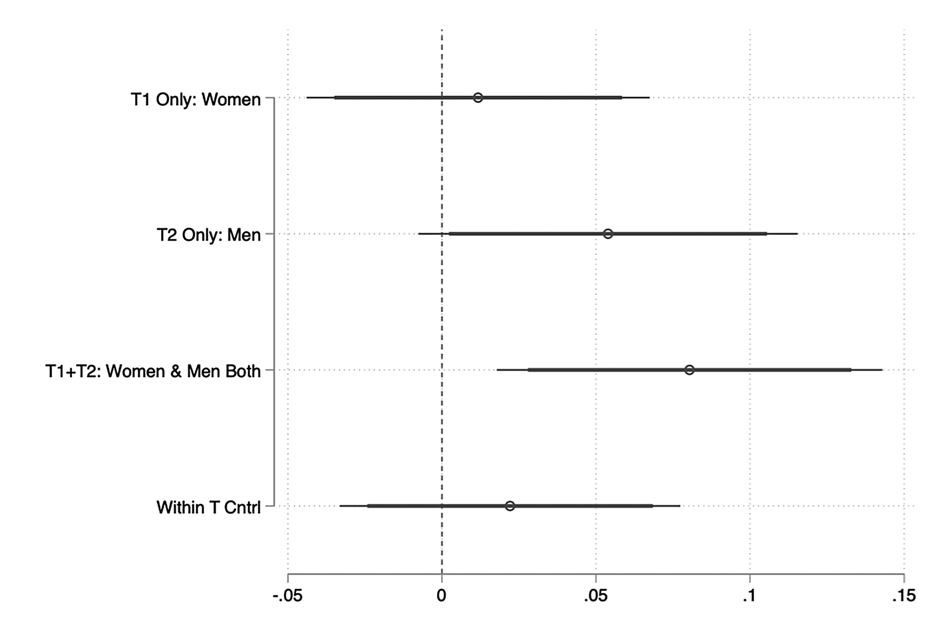
Evidence from Pakistan demonstrates that, in contexts where men act as gatekeepers, efforts to improve political outcomes for women need to engage men
Women vote at much lower rates than men in many developing countries. In Pakistan, this gap is particularly stark: women’s turnout was 9.1 percentage points lower than that of men in the 2018 election. This meant that the set of voters who decided the election included 11 million more men than women.
The gender gap in voting matters because women tend to have distinct policy preferences, which are often geared towards better welfare outcomes for women and children (Chattopadhyay and Duflo 2004, Khan 2020). If women have an inequitable voice in electoral outcomes, policy may skew away from their preferences and hence may reduce women’s welfare. The gender gap also matters for normative reasons: democratic equality is one of the core principles of democracy (Dahl1973).
Closing the gender gap
Interventions aimed at increasing women’s participation in politics typically centre on improving women’s access to the ‘resources’ needed to participate. These resources include, for example, information, interest, civic skills and self-efficacy. Evidence on the efficacy of such interventions is mixed, ranging from positive effects in rural Pakistan (Gine and Mansuri 2008), null effects in Ghana (Ichino and Nathan 2017) to negative effects of a civic education campaign in Mali (Gottlieb 2016).
These interventions implicitly assume that the decision of whether to vote or not rests with women themselves. This may not be true in patriarchal contexts where men act as “gatekeepers” within households. Gatekeeping need not mean actively restricting women’s participation. In our setting, over 90% of men think it is ``appropriate’’ for women to vote. However, due to restrictions on autonomous mobility, women still depend on men for accompaniment and transport to enable access to polling stations. In such contexts, any interventions aimed at increasing women’s participation might need to involve these male gatekeepers.
Experimental design
In our research (Cheema, Khan, Liaqat and Mohmand 2023), we designed an experiment to test whether the constraints to women’s voting lie with the women themselves, or with the men in their households who act as gatekeepers. We ran this experiment in partnership with two prominent Pakistani civil society organisations (Aurat Foundation and South Asia Partnership – Pakistan) in 2500 households in Lahore, Pakistan’s second largest city.
The intervention is a nonpartisan, door-to-door voter canvassing campaign aimed at increasing women’s turnout in Pakistan’s 2018 election through a bundle of motivational and informational messaging. While canvassing field experiments often vary the mode or content of delivery, our experiment randomly varies the target of the campaign in sample households. Households are randomly assigned to receive a canvassing visit from a female canvasser targeting women (T1 only), a visit by a male canvasser targeting men (T2 only), both visits conducted separately (T1+T2), or no visit (control).
We measure women’s turnout by visually verifying indelible ink marks placed on voters’ thumbs once they cast their votes. We also measure additional behavioural and attitudinal outcomes during a visit two months after the intervention.
Results: Targeting men is necessary to increase women’s turnout
We find that targeting just women with a canvassing visit (T1 only) does not significantly increase women’s turnout. This indicates that individual-level resources such as information or motivation may not be what holds women back from voting in greater numbers.
However, targeting just men (T2 only) raises turnout by 5.4 percentage points and targeting both men and women (T1+T2) raises turnout by 8.0 percentage points - targeting men is necessary to increase women’s turnout in this context. This result is in line with our theory of gatekeeping which suggests that in patriarchal contexts where men exercise control over women’s lives, engaging them is necessary to achieve gains in women’s political participation.
Figure 1: Intervention impacts on womens' voting

We also found that the intervention had lasting effects on men’s support for women’s role in democracy. Two months after the election, we offered men in study households the option to post a publicly visible sticker on the entryway of their residence. We cross-randomised whether men were offered a sticker with a generic message of support for democracy or a sticker with a message of support for women’s role in democracy. This allows us to interpret any difference in take-up of the two stickers as men’s willingness to publicly endorse women’s political participation. We find that men in households where both men and women are canvassed (T1 + T2) are significantly more likely to express support for women’s role in democracy than are men in control households.
One potential concern with an intervention involving men is that it may further reduce women’s autonomy if these men end up coercing women to vote a certain way. While autonomy is challenging to measure directly, we rely on a validated proxy psychological measure: the relative autonomy index (Ryan and Deci 2000). Using this measure, we find no evidence that any of our treatment arms reduced women’s sense of autonomy or led to an increased feeling of coercion or social pressure.
Implications and conclusion
Our results speak to the need to engage men to improve political outcomes for women in cases where men act as gatekeepers. We must be mindful that this does not amount to challenging the status quo of gender relations or gatekeeping itself. Also, our evidence may not generalise to cases where underlying norms and attitudes deem women’s participation socially inappropriate. For instance, our survey data shows that attitudes and norms related to women running for elections are not nearly as permissive as voting. A short term intervention like ours that is unlikely to change these attitudes and norms may not affect political selection.
These findings also speak to an oft-neglected consequences of urbanisation in developing countries with restrictive gender norms. Women in rural Pakistan generally enjoy relative freedom within the village boundary (Cheema et al. 2020), but cities tend not to provide a safe boundary within which women have mobility without the restrictions imposed by male gatekeepers. While our evidence only speaks to the consequence of such restrictions in the political sphere, they may also contribute to the continued low rates of female labour force participation in Pakistani cities.
The act of going to the polling booth to cast your vote is a public act, one that is difficult or impossible for women to engage in without others in their household finding out about it. Gender dynamics for such public acts are very different from those for private acts. Ashraf et al. (2014) study the private act of taking contraceptives in Zambia. They find that when women are privately given access to contraceptives, they are 27% less likely to give birth compared to when they are given access with their husbands. The relative efficacy of a direct private treatment to women in this domain stands in stark contrast to our results and speaks to the need to understand the nuances of women’s welfare in different domains. While women’s welfare may be improved by placing them front and centre of interventions in some domains, in other domains the status quo may dictate that short-run improvements are only possible by working through those who gatekeep women’s access to resources that unlock their welfare.
References
Ashraf, N, E Field, and J Lee (2014), “Household bargaining and excess fertility: an experimental study in Zambia.” American Economic Review 104(7): 2210-2237.
Chattopadhyay, R, and E Duflo (2004), “Women as Policy Makers: Evidence from a Randomized Policy Experiment in India.” Econometrica 72(5): 1409–43.
Cheema, A, S Khan, A Liaqat and S K Mohmand (2023) "Canvassing the gatekeepers: A field experiment to increase women voters’ turnout in Pakistan." American Political Science Review 117(1): 1-21.
Cheema, A, A I Khwaja, F Naseer, and J N Shapiro (2020), “Glass Walls: Experimental Evidence on Access Constraints Faced by Women.” Unpublished Manuscript. https://scholar.princeton.edu/sites/default/files/jns/files/ckns_glass_walls_2022-02-04.pdf
Dahl, R A (1973), Polyarchy: Participation and Opposition. New Haven, CT: Yale University Press.
Giné, X, and G Mansuri (2018), “Together We Will: Experimental Evidence on Female Voting Behavior in Pakistan.” American Economic Journal: Applied Economics 10(1): 207–35.
Gottlieb, J (2016), “Why Might Information Exacerbate the Gender Gap in Civic Participation? Evidence from Mali.” World Development 86: 95–110
Ichino, N, and N L Nathan. 2018. “Political Party Organization and Women’s Empowerment: A Field Experiment in Ghana.” International Growth Center. Final Report: S-33403-GHA-1.
Khan, S (2020), “Making Democracy Work for Women: Essays on Women’s Political Participation in Pakistan.” PhD diss. Columbia University.
Ryan, R M and E L Deci (2000), “Self-Determination Theory and the Facilitation of Intrinsic Motivation, Social Development, and Well-Being.” American Psychologist 55(1):68–78.




